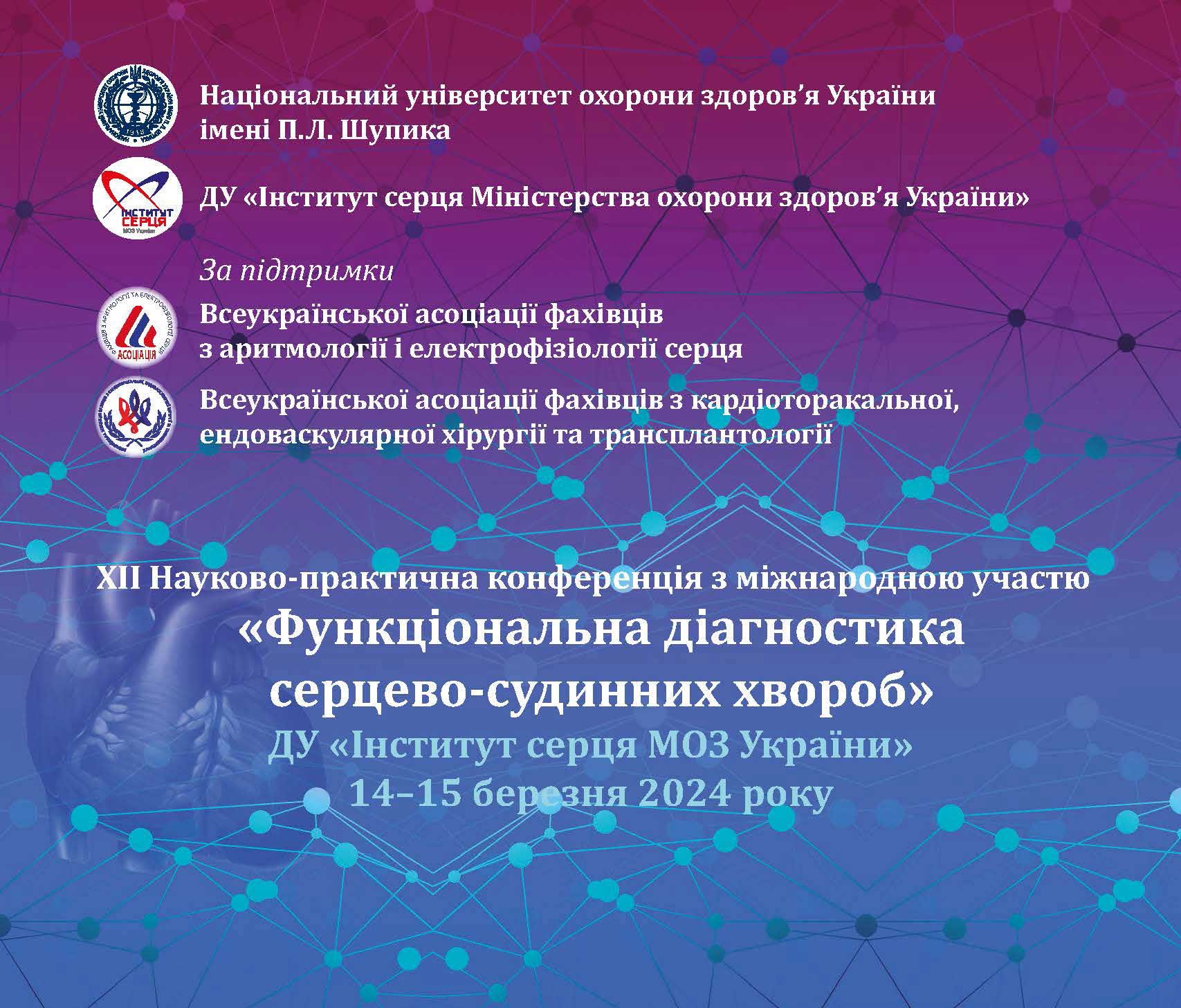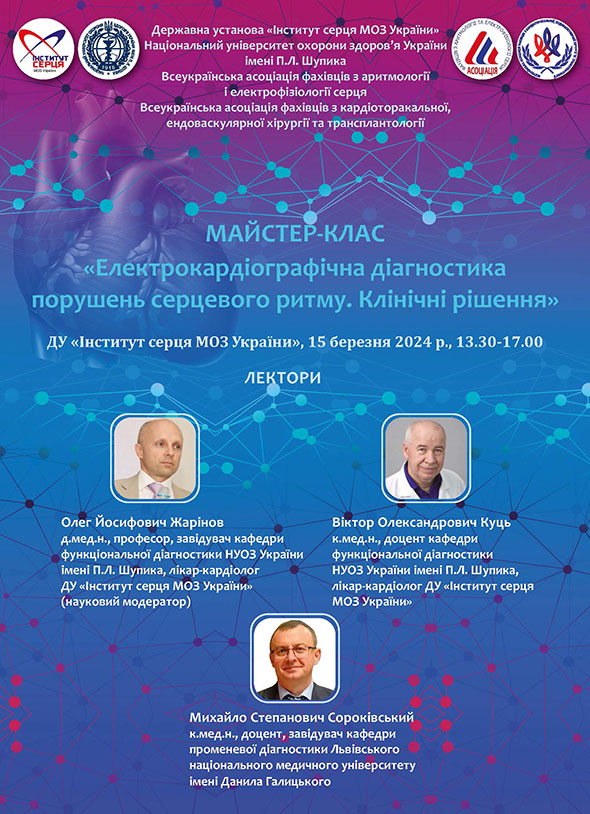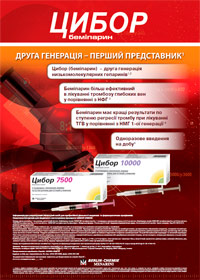Посттравматичний стресовий розлад у пацієнтів із серцево-судинною патологією
А.С. Солонович, О.С. Солонович, О.А. Єпанчінцева
Література
- Nakaz Ministerstva okhorony zdorovʺya Ukrayiny 23.02.2016 № 121. Unifikovanyy klinichnyy protokol pervynnoyi, vtorynnoyi (spetsializovanoyi) ta tretynnoyi (vysokospetsializovanoyi) medychnoyi dopomohy. Reaktsiya na stres ta rozlady
- Abla M. Sibai, Fletcher A, Armenian HK. Variations in the impact of long-term wartime stressors on mortality among the middle-aged and older population in Beirut, Lebanon, 1983–1993. Amer J Epidemiol. 2001;154(2):128-37. https://doi.org/10.1093/aje/154.2.128.
- Ahmadi N, Hajsadeghi F, Mirshkarlo HB, Budoff M, Yehuda R, Ebrahimi R. Post-traumatic stress disorder, coronary atherosclerosis, and mortality. Am J Cardiol. 2011;108:29-33.
- Amadio P, Zarà M, Sandrini L, Ieraci A, Barbieri SS. Depression and cardiovascular disease: The Viewpoint of Platelets. International J Molecular Scien. 2020;21(20):7560. https://doi.org/10.3390/ijms21207560.
- Austin AW, Wissmann T, Von Kanel R. Stress and hemostasis: An update. Semin Thromb Hemost. 2013;39:902-12.
- Avaro A, Gerosa G, Caforio AL, et al. Posttraumatic stress disorder and depression in heart transplantation recipients: the relationship with outcome and adherence to medical treatment. Gen Hosp Psychiatry. 2011;33:1-7.
- Bandelow B, Baldwin D, Abelli M, Bolea-Alamanac B, Bourin M, Chamberlain SR, et al. Biological markers for anxiety disorders, OCD and PTSD: a consensus statement. part II: neurochemistry, neurophysiology and neurocognition. World J. Biol. Psychiatry. 2017;183:162-214. doi:10.1080/15622975.2016.1190867.
- Bedi US, Arora R. Cardiovascular manifestations of posttraumatic stress disorder. J Natl Med Assoc. 2007;99:642-9.
- Beis D, von Kanel R, Heimgartner N, Zuccarella-Hackl C, Burkle A, Ehlert U, et al. The role of norepinephrine and alpha-adrenergic receptors in acute stress-induced changes in granulocytes and monocytes. Psychosom. Med. 2018;807: 649-58. doi:10.1097/PSY.0000000000000620.
- Belkin MR, Schwartz TL. Alpha-2 receptor agonists for the treatment of posttraumatic stress disorder. Drugs Context. 2015;4:212286. doi: 10.7573/dic.212286.
- Breslau N, Davis GC, Schultz LR. Posttraumatic stress disorder and the incidence of nicotine, alcohol, and other drug disorders in persons who have experienced trauma. Arch Gen Psychiatry. 2003;60:289-94.
- Buckley TC, Kaloupek DG. A meta-analytic examination of basal cardiovascular activity in posttraumatic stress disorder. Psychosom Med. 2001;63:585-94.
- Burg MM, Brandt C, Buta E, Schwartz J, Bathulapalli H, Dziura J, Edmondson DE, Haskell S. Risk for incident hypertension associated with posttraumatic stress disorder in military veterans and the effect of posttraumatic stress disorder treatment. Psychosom Med. 2017;79(2):181-8. doi: 10.1097/PSY.0000000000000376. PMID: 27490852; PMCID: PMC5285494.
- Byrne CJ, Khurana S, Kumar A, Tai TC. Inflammatory signaling in hypertension: regulation of adrenal catecholamine biosynthesis. Front Endocrinol (Lausanne). 2018;9:343.
- doi: 10.3389/fendo.2018.00343. PMID: 30013513; PMCID: PMC6036303.
- Ceylan ME, Alpsan-Omay MH. Bleeding induced by SSRIs. Eur Psychiatry. 2005;20:570-1.
- Cleveland S, Reed K, Thomas JL, Ajijola OA, Ebrahimi R, Hsiai T, Lazarov A, Montoya AK, Neria Y, Shimbo D, Wolitzky-Taylor K, Sumner JA. Key dimensions of post-traumatic stress disorder and endothelial dysfunction: a protocol for a mechanism-focused cohort study. BMJ Open. 2021;5;11(5):e043060. doi: 10.1136/bmjopen-2020-043060. PMID: 33952541; PMCID: PMC8103395.
- Cojocariu SA, Maștaleru A, Sascău RA, Stătescu C, Mitu F, Leon-Constantin MM. Neuropsychiatric consequences of lipophilic beta-blockers. Medicina (Kaunas). 2021;57(2):155. doi: 10.3390/medicina57020155. PMID: 33572109; PMCID: PMC7914867.
- Coughlin SS. Post-traumatic stress disorder and cardiovascular disease. Open Cardiovasc Med J. 2011;5:164-70. doi: 10.2174/1874192401105010164. Epub 2011 Jul 11. PMID: 21792377; PMCID: PMC3141329. de Abajo FJ. Effects of selective serotonin reuptake inhibitors on platelet function: mechanisms, clinical outcomes and implications for use in elderly patients. Drugs Aging. 2011;28:345-67.
- Dennis PA, Kimbrel NA, Sherwood A, Calhoun PS, Watkins LL, Dennis MF, Beckham JC. Trauma and autonomic dysregulation: episodic-versus systemic-negative affect underlying cardiovascular risk in posttraumatic stress disorder. Psychosom Med. 2017;79(5):496-505. doi: 10.1097/PSY.0000000000000438. PMID: 28570433; PMCID: PMC5466498.
- Diagnostic and statistical manual of mental disorders. 5th ed. Washington, DC: American Psychiatric Association; 2013.
- Edmondson D, von Känel R. Post-traumatic stress disorder and cardiovascular disease. Lancet Psychiatry. 2017;4(4):320-9. doi: 10.1016/S2215-0366(16)30377-7. Epub 2017 Jan 19. PMID: 28109646; PMCID: PMC5499153.
- Edmondson D. An enduring somatic threat model of posttraumatic stress disorder due to acute life-threatening medical events. Soc Personal Psychol Compass. 2014;8:118-34.
- Edmondson DE, Kronish IM, Shaffer JA, Falzon L, Burg MM. Posttraumatic stress disorder and risk for coronary heart disease: A meta-analytic review. Am Heart J. 2013;166:806-14.
- Fagiolini A, Comandini A, Catena Dell’Osso M, Kasper S. Rediscovering trazodone for the treatment of major depressive disorder. CNS Drugs. 2012;26:1033-1049.
- Fox KM. Current status: heart rate as a treatable risk factor. Eur Heart J. 2011;13(suppl C):C30-C6.
- Gander ML, von Kanel R. Myocardial infarction and post-traumatic stress disorder: frequency, outcome, and atherosclerotic mechanisms. Eur J Cardiovasc Prev Rehabil. 2006;13:165-72.
- Giustino TF, Fitgerald PG, Maren S. Revisiting propranolol and PTSD: Memory erasure or extinction enhancement? Neurobiology of learning and memory. 2016;130:26-33. doi:10.1016/j.nlm.2016.01.009.
- Grenon SM, Owens CD, Alley H, Perez S, Whooley MA, Neylan TC, Aschbacher K, Gasper WJ, Hilton JF, Cohen BE. Posttraumatic stress disorder is associated with worse endothelial function among veterans. J Am Heart Assoc. 2016;5(3):e003010. doi: 10.1161/JAHA.115.003010. PMID: 27009621; PMCID: PMC4943274.
- Grenon SM, Chong K, Alley H, Nosova E, Gasper W, Hiramoto J, Boscardin WJ, Owens CD. Walking disability in patients with peripheral artery disease is associated with arterial endothelial function. J Vasc Surg. 2014;59(4):1025-34. doi: 10.1016/j.jvs.2013.10.084. Epub 2014 Jan 11. PMID: 24423479; PMCID: PMC3966931.
- Haensel A, Mills PJ, Nelesen RA, Ziegler MG, Dimsdale JE. The relationship between heart rate variability and inflammatory markers in cardiovascular diseases. Psychoneuroendocrinology. 2008;33:1305-12.
- Jansen JO, Lord JM, Thickett DR, Midwinter MJ, McAuley DF, Gao F. Clinical review: Statins and trauma--a systematic review. Crit Care. 2013;17(3):227. doi: 10.1186/cc12499. PMID: 23751018; PMCID: PMC3706835.
- Kang HK, Bullman TA, Taylor JW. Risk of selected cardiovascular diseases and posttraumatic stress disorder among former World War II prisoners of war. Annals Epidemiology. 2016;5(16):381-6. doi.org/10.1016/j.annepidem.2005.03.004.
- Karlovic D, Buljan D, Martinac M, et al. Serum lipid concentrations in Croatian veterans with post-traumatic stress disorder, post-traumatic stress disorder comorbid with major depressive disorder, or major depressive disorder. J Korean Med Sci. 2004;19:431-6.
- Khoury NM, Marvar PJ, Gillespie CF, et al. The reninangiotensin pathway in posttraumatic stress disorder: angiotensin-converting enzyme inhibitors and angiotensin receptor blockers are associated with fewer traumatic stress symptoms. J Clin Psychiatry. 2012;73(6):849-55.
- Koenen KC, Galea S. Post-traumatic stress disorder and chronic disease: open questions and future directions. Soc Psychiatry Psychiatr Epidemiol. 2015;50:511-3.
- Koenen KC, Ratanatharathorn A, Ng L, et al. Posttraumatic stress disorder in the World Mental Health Surveys. Psychol Med. 2017;47(13):2260-74. doi: 10.1017/S0033291717000708. Epub 2017 Apr 7. PMID: 28385165; PMCID: PMC6034513.
- Kronish IM, Cornelius T, Schwartz JE, et al. Posttraumatic Stress Disorder and Electronically Measured Medication Adherence After Suspected Acute Coronary Syndromes. Circulation. 2020;142(8):817-9. doi:10.1161/CIRCULATIONAHA.120.045714.
- Kronish IM, Edmondson D, Goldfinger J, et al. Posttraumatic stress disorder and adherence to medications in survivors of strokes and transient ischemic attacks. Stroke. 2012;43(8):2192-7. doi:10.1161/STROKEAHA.112.655209.
- Kronish IM, Edmondson D, Moise N, et al. Posttraumatic stress disorder in patients who rule out versus rule in for acute coronary syndrome. Gen Hosp Psychiatry. 2018;53:101-7. doi: 10.1016/j.genhosppsych.2018.02.007. Epub 2018 May 16. PMID: 29773309; PMCID: PMC6291417.
- Kronish IM, Moise N, Bleck R, et al. PTSD and aversive cognitive associations about aspirin in acute coronary syndrome patients. Am Psychosomatic Society; Savannah, GA: 2015.
- Kronish IM, Ye S. Adherence to cardiovascular medications: lessons learned and future directions. Prog Cardiovasc Dis. 2013;55(6):590-600. doi: 10.1016/j.pcad.2013.02.001. Epub 2013 Mar 23. PMID: 23621969; PMCID: PMC3639439.
- Lakusic N, Fuckar K, Mahovic D, et al. Characteristics of heart rate variability in war veterans with post-traumatic stress disorder after myocardial infarction. Mil Med. 2007;172:1190-3.
- Letsas K, Korantzopoulos P, Pappas L, et al. QT interval prolongation associated with venlafaxine administration. Int J Cardiol. 2006;109:116-7.
- Liberzon I, Abelson JL, Flagel SB, et al. Neuroendocrine and psychophysiologic Responses in PTSD: A Symptom Provocation Study. Neuropsychopharmacology. 1999;21(1):40-50. doi:10.1016/S0893-133X(98)001286.
- Lima BB, Hammadah M, Wilmot K, et al. Posttraumatic stress disorder is associated with enhanced interleukin-6 response to mental stress in subjects with a recent myocardial infarction. Brain Behav Immun. 2019;75:26-33. doi: 10.1016/j.bbi.2018.08.015.
- Lok A, Frijling JL, van Zuiden M. Posttraumatic stress disorder: current insights in diagnostics, treatment and prevention. Ned Tijdschr Geneeskd. 2018;161:D1905.
- LoVecchio F, Riley B, Pizon A, et al. Outcomes after isolated mirtazapine (Remeron) supratherapeutic ingestions. J Emerg Med. 2008;34:77-8.
- Moraru A, Proca E, Zavadovschi A, et al. Post-traumatic stress disorder and cardiovascular disease. Romanian Journal of Military Medicine. 2022;CXXV: 97-111. doi:10.55453/rjmm.2022.125.1.13.
- Morris MC, Compas BE, Garber J. Relations among posttraumatic stress disorder, comorbid major depression, and HPA function: a systematic review and meta-analysis. Clin Psychol Rev. 2012;32:301-15.
- Pacher P, Kecskemeti V. Cardiovascular side effects of new antidepressants and antipsychotics: new drugs, old concerns? Curr Pharm Des. 2004;10:2463-75.
- Pacher P, Ungvari Z, Nanasi PP, et al. Speculations on difference between tricyclic and selective serotonin reuptake inhibitor antidepressants on their cardiac effects. Is there any? Curr Med Chem. 1999;6:469-80.
- Palmer MC. Treating comorbid posttraumatic stress disorder and cardiovascular disease. Current Psychiatry. 2017;16(8):38-42.
- Pan X, Kaminga AC, Wen SW, Liu A. Catecholamines in post-traumatic stress disorder: A systematic review and meta-analysis. Front Mol Neurosci. 2018;11:450. doi: 10.3389/fnmol.2018.00450. PMID: 30564100; PMCID: PMC6288600.
- Passos IC, Vasconcelos-Moreno MP, Costa LG, et al. Inflammatory markers in post-traumatic stress disorder: a systematic review, meta-analysis, and meta-regression. Lancet Psychiatry. 2015;2:1002–12.
- Piccirillo G, Magrì D, Matera S, et al. QT variability strongly predicts sudden cardiac death in asymptomatic subjects with mild or moderate left ventricular systolic dysfunction: a prospective study. Eur Heart J. 2007;28:1344-50.
- Pole N, Pole N. The psychophysiology of posttraumatic stress disorder: a meta-analysis. Psychol Bull. 2007;133:725-46.
- Pope B, Wood S. Stress-induced inflammation as the «connexin» between post-traumatic stress disorder and cardiovascular disease. Brain, Behavior, and Immunity. 2019;82:3-5.doi: 10.1016/j.bbi.2019.08.182.
- Raskind MA, Peskind ER, Kanter ED, et al. Reduction of nightmares and other PTSD symptoms in combat veterans by prazosin: a placebo-controlled study. Am J Psychiatry. 2003;160(2):371-3.
- Rasmusson AM, Schnurr PP, Zukowska Z, et al. Adaptation to extreme stress: post-traumatic stress disorder, neuropeptide Y and metabolic syndrome. Exp Biol Med (Maywood). 2010;235(10):1150-62. doi: 10.1258/ebm.2010.009334. PMID: 20881319.
- Robicsek O, Makhoul B, Klein E, et al. Hypercoagulation in Chronic Post-Traumatic Stress Disorder. Isr Med Assoc J. 2011;13:548-52.
- Rodriguez de la Torre B, Dreher J, Malevany I, et al. Serum levels and cardiovascular effects of tricyclic antidepressants and selective serotonin reuptake inhibitors in depressed patients. Ther Drug Monit. 2001;23:435-40.
- Rosenbaum S, Stubbs B, Ward PB, et al. The prevalence and risk of metabolic syndrome and its components among people with posttraumatic stress disorder: a systematic review and meta-analysis. Metabolis. 2015;64:926-33.
- Rosman L, Lampert R, Ramsey CM, et al. Posttraumatic Stress Disorder and Risk for Early Incident Atrial Fibrillation: A Prospective Cohort Study of 1.1 Million Young Adults. J Am Heart Assoc. 2019;8(19):e013741. doi: 10.1161/JAHA.119.013741. Epub 2019 Sep 28. PMID: 31564191; PMCID: PMC6806049.
- Rozanski A, Blumenthal JA, Davidson KW, et al. The epidemiology, pathophysiology, and management of psychosocial risk factors in cardiac practice: The emerging field of behavioral cardiology. J Am Coll Cardiol. 2005;45:637-51.
- Saavedra JM, Sánchez-Lemus E, Benicky J. Blockade of brain angiotensin II AT1 receptors ameliorates stress, anxiety, brain inflammation and ischemia: Therapeutic implications. Psychoneuroendocrinology. 2011;36(1):1-18. doi: 10.1016/j.psyneuen.2010.10.001.
- Sala M, Lazzaretti M, De Vidovich G, et al. Electrophysiological changes of cardiac function during antidepressant treatment. Ther Adv Cardiovasc Dis. 2009;3:29-43.
- Schrader C, Ross A. A review of PTSD and current treatment strategies. Mo Med. 2021;118(6):546-51. PMID: 34924624; PMCID: PMC8672952.
- Service JA, Waring WS. QT Prolongation and delayed atrioventricular conduction caused by acute ingestion of trazodone. Clin Toxicol (Phila) 2008;46:71-3.
- Shemesh E, Yehuda R, Milo O, et al. Posttraumatic stress, nonadherence, and adverse outcome in survivors of a myocardial infarction. Psychosom Med. 2004;66:521-6.
- Shemesh E. A pilot study of posttraumatic stress and nonadherence in pediatric liver transplant recipients. Pediatrics. 2000;105(2):E29. doi:10.1542/peds.105.2.e29.
- Sun HJ, Wu ZY, Nie XW, et al. Role of endothelial dysfunction in cardiovascular diseases: The link between inflammation and hydrogen sulfide. Front Pharmacol. 2020;10:1568. doi: 10.3389/fphar.2019.01568. PMID: 32038245; PMCID: PMC6985156.
- Tarabar AF, Hoffman RS, Nelson L. Citalopram overdose: late presentation of torsades de pointes (TdP) with cardiac arrest. J Med Toxicol. 2008;4:101-5.
- Tchernof A, Després JP. Pathophysiology of human visceral obesity: an update. Physiol Rev. 2013;93(1):359-404. doi: 10.1152/physrev.00033.2011. PMID: 23303913.
- Thanacoody HK, Thomas SH. Tricyclic antidepressant poisoning: cardiovascular toxicity. Toxicol Rev. 2005;24:205-14.
- van der Kolk B. Posttraumatic stress disorder and the nature of trauma. Dialogues Clin Neurosci. 2000;2(1):7-22. doi:10.31887/DCNS.2000.2.1/bvdkolk.
- von Kanel R, Orth-Gomer K. Autonomic function and prothrombotic activity in women after an acute coronary event. J Womens Health (Larchmt) 2008;17:1331-7.
- Warne JP. Shaping the stress response: Interplay of palatable food choices, glucocorticoids, insulin and abdominal obesity. Mol Cell Endocrinol. 2009;300(1–2):137-46.
- Widmer RJ, Lerman A. Endothelial dysfunction and cardiovascular disease. Glob Cardiol Sci Pract. 2014;16(3):291-308. doi: 10.5339/gcsp.2014.43. PMID: 25780786; PMCID: PMC4352682.
- Wilson PG, Thompson JC, Shridas P, et al. Serum amyloid A
- is an exchangeable apolipoprotein. Arterioscler Thromb
- Vasc Biol. 2018;38(8):1890-900. doi: 10.1161/ATVBAHA.118.310979.
- Yehuda R. Advances in understanding neuroendocrine alterations in PTSD and their therapeutic implications. Ann NY Acad Sci. 2006;1071:137-66.
- Yekehtaz H, Farokhnia M, Akhondzadeh S. Cardiovascular considerations in antidepressant therapy: an evidence-based review. J Tehran Heart Cent. 2013 28;8(4):169-76.
- Zen AL, Whooley MA, Zhao S, et al. Post-traumatic stress disorder is associated with poor health behaviors: Findings from the Heart and Soul Study. Health Psychol. 2012;31:194-201.
| [PDF] | [Зміст журналу] |












